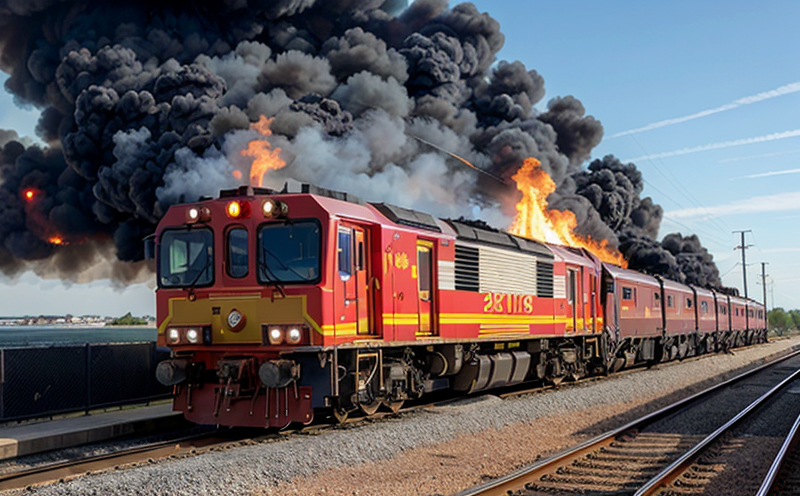Fire Resistance Testing of Railway Flooring Materials
Fire resistance testing of railway flooring materials is a critical process that ensures the safety and integrity of train carriages. This testing evaluates how effectively various flooring materials can withstand high temperatures, flames, and other fire-related hazards without compromising structural stability or causing harmful emissions.
The significance of this test cannot be overstated in sectors like transportation where passenger safety is paramount. Fire resistance testing helps identify the most suitable materials for railway floors to prevent fires from spreading rapidly within enclosed spaces. This not only protects passengers but also ensures that rescue operations are less complicated and safer for first responders.
During these tests, samples of flooring materials undergo controlled exposure to heat and flame under specified conditions outlined by standards such as ISO 16777-2:2015 or ASTM E84. These standards define the procedures required to measure both the flame spread rating (FSR) and smoke developed class (SDC), which are crucial metrics for assessing fire performance.
For accurate testing, materials must be prepared according to prescribed methods, ensuring consistent results across multiple trials. Proper specimen preparation involves cutting samples into standard sizes suitable for insertion into the testing apparatus. This ensures that every test provides meaningful data reflecting real-world scenarios rather than anomalies due to improper sample handling.
The chosen instrumentation plays a vital role in achieving reliable outcomes. Key pieces of equipment include non-combustible furnaces designed to generate consistent temperatures and controlled atmospheres conducive to simulating actual fire conditions experienced by railway floors during emergencies. Additionally, specialized optical systems equipped with infrared cameras capture detailed images throughout the testing process allowing analysts to closely monitor material behavior over time.
Test results are documented meticulously in comprehensive reports detailing all relevant parameters observed during each trial run. These documents serve as valuable references for quality assurance departments responsible for maintaining high standards within their respective organizations. They also provide essential information needed by regulatory bodies overseeing safety regulations applicable to railway operations worldwide.
Why It Matters
The importance of fire resistance testing cannot be overstated, especially when applied to critical infrastructure like railways where prolonged exposure to flames or excessive heat could lead to catastrophic failures. By conducting rigorous tests on flooring materials used in trains, manufacturers and designers can ensure that these products meet strict safety requirements set forth by international standards.
In addition to enhancing passenger safety, successful completion of fire resistance testing contributes significantly towards reducing potential damage caused by fires within train carriages. This reduces maintenance costs associated with replacing burnt-out sections faster than if left unattended for extended periods, thereby improving overall operational efficiency.
Industry Applications
| Application | Description |
|---|---|
| Railway Passenger Cars | Ensuring safe evacuation routes and preventing spread of fire through flooring materials. |
| Freight Wagons | Protecting cargo from smoke inhalation during emergencies, maintaining structural integrity post-fire. |
| Application | Description |
|---|---|
| Subway Stations | Providing durable flooring that can withstand harsh environmental conditions while resisting ignition. |
| Tunnel Entrances | Avoiding hazardous situations where flames might spread rapidly due to poor ventilation. |
Environmental and Sustainability Contributions
- Reduces waste from non-compliant products by identifying robust materials upfront.
- Promotes use of recycled content in flooring compositions, reducing demand on virgin resources.
- Encourages development of innovative solutions that enhance both safety and sustainability simultaneously.





